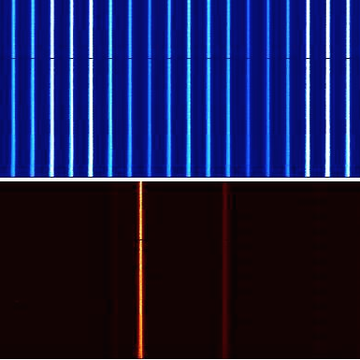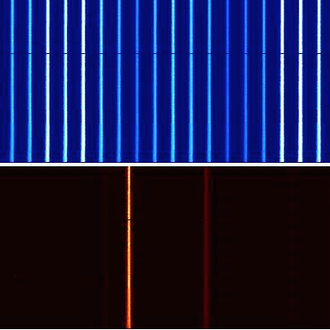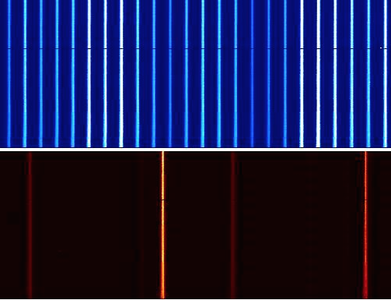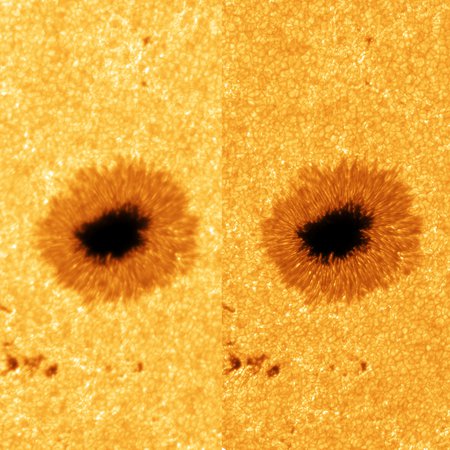A universal comb

Selected spectrum of the optical frequency comb (upper, blue panel) as compared to a Neon spectral lamp emission (lower red panel). The comb is a better calibrator („optical ruler“), because it features more and equally spaced emission lines than the Neon lamp.
Credit: AIPScientists from the Leibniz Institute for Astrophysics in Potsdam (AIP) and the Centre for innovation competence innoFSPEC have tested a novel optical frequency comb using an astronomical instrument. This new light source will improve the calibration of spectrographs and hence their scientific measurements.
"The special quality of the light generated by the optical frequency comb is that it consists of individual, discrete colours, with a precise frequency spacing," explains the responsible innoFSPEC scientist Jose Boggio. „The optical comb is created by the superposition of laser light with two different frequencies.“ The resulting comb spectrum is not continuous, as in a rainbow, but consists of different coloured lines with fixed spacing and dark gaps between - hence the name frequency comb.
To analyse the light from stars and galaxies, all spectrographs must be calibrated using a known light source. "The frequency comb serves as optical ruler that is more stable and regular, than the light from conventional spectral calibration lamps", explains astrophysicist Andreas Kelz. "Thanks to these methods, we will be able to determine the rotational speeds of galaxies or the chemical composition of stars more precisely."
After development in the laboratories of innoFSPEC Potsdam, the frequency comb has undergone a first practical test on sky. During a recent observing campaign at the Calar Alto Observatory in southern Spain, the AIP-built PMAS spectrograph was equipped with the frequency comb. After the successful outcome of these tests, Roger Haynes, head of the innoFSPEC research group, is sure that laser frequency combs will set new standards in astronomical precision spectroscopy and laboratory analysis.
Back in 2005, Professor Hänsch from the Max-Planck-Institute for quantum optics, received the Nobel Prize for the development of an optical frequency comb. However, the device developed in Potsdam is based on a different principle of operation and produces comb-lines with a much larger pitch. This makes it applicable for typical astronomical night-time spectrograph operating at low and medium resolution.
Science contacts:
Dr. Jose Chavez-Boggio, jboggio@aip.de, +49 331-7499 665
Dr. Andreas Kelz, akelz@aip.de, +49 331-7499 640
Media contact: Kerstin Mork, presse@aip.de, +49 331-7499 469

Selected spectrum of the optical frequency comb (upper, blue panel) as compared to a Neon spectral lamp emission (lower red panel). The comb is a better calibrator („optical ruler“), because it features more and equally spaced emission lines than the Neon lamp.
Credit: AIPScientists from the Leibniz Institute for Astrophysics in Potsdam (AIP) and the Centre for innovation competence innoFSPEC have tested a novel optical frequency comb using an astronomical instrument. This new light source will improve the calibration of spectrographs and hence their scientific measurements.
"The special quality of the light generated by the optical frequency comb is that it consists of individual, discrete colours, with a precise frequency spacing," explains the responsible innoFSPEC scientist Jose Boggio. „The optical comb is created by the superposition of laser light with two different frequencies.“ The resulting comb spectrum is not continuous, as in a rainbow, but consists of different coloured lines with fixed spacing and dark gaps between - hence the name frequency comb.
To analyse the light from stars and galaxies, all spectrographs must be calibrated using a known light source. "The frequency comb serves as optical ruler that is more stable and regular, than the light from conventional spectral calibration lamps", explains astrophysicist Andreas Kelz. "Thanks to these methods, we will be able to determine the rotational speeds of galaxies or the chemical composition of stars more precisely."
After development in the laboratories of innoFSPEC Potsdam, the frequency comb has undergone a first practical test on sky. During a recent observing campaign at the Calar Alto Observatory in southern Spain, the AIP-built PMAS spectrograph was equipped with the frequency comb. After the successful outcome of these tests, Roger Haynes, head of the innoFSPEC research group, is sure that laser frequency combs will set new standards in astronomical precision spectroscopy and laboratory analysis.
Back in 2005, Professor Hänsch from the Max-Planck-Institute for quantum optics, received the Nobel Prize for the development of an optical frequency comb. However, the device developed in Potsdam is based on a different principle of operation and produces comb-lines with a much larger pitch. This makes it applicable for typical astronomical night-time spectrograph operating at low and medium resolution.
Science contacts:
Dr. Jose Chavez-Boggio, jboggio@aip.de, +49 331-7499 665
Dr. Andreas Kelz, akelz@aip.de, +49 331-7499 640
Media contact: Kerstin Mork, presse@aip.de, +49 331-7499 469
Images
Selected spectrum of the optical frequency comb (upper, blue panel) as compared to a Neon spectral lamp emission (lower red panel). The comb is a better calibrator („optical ruler“), because it features more and equally spaced emission lines than the Neon lamp.



